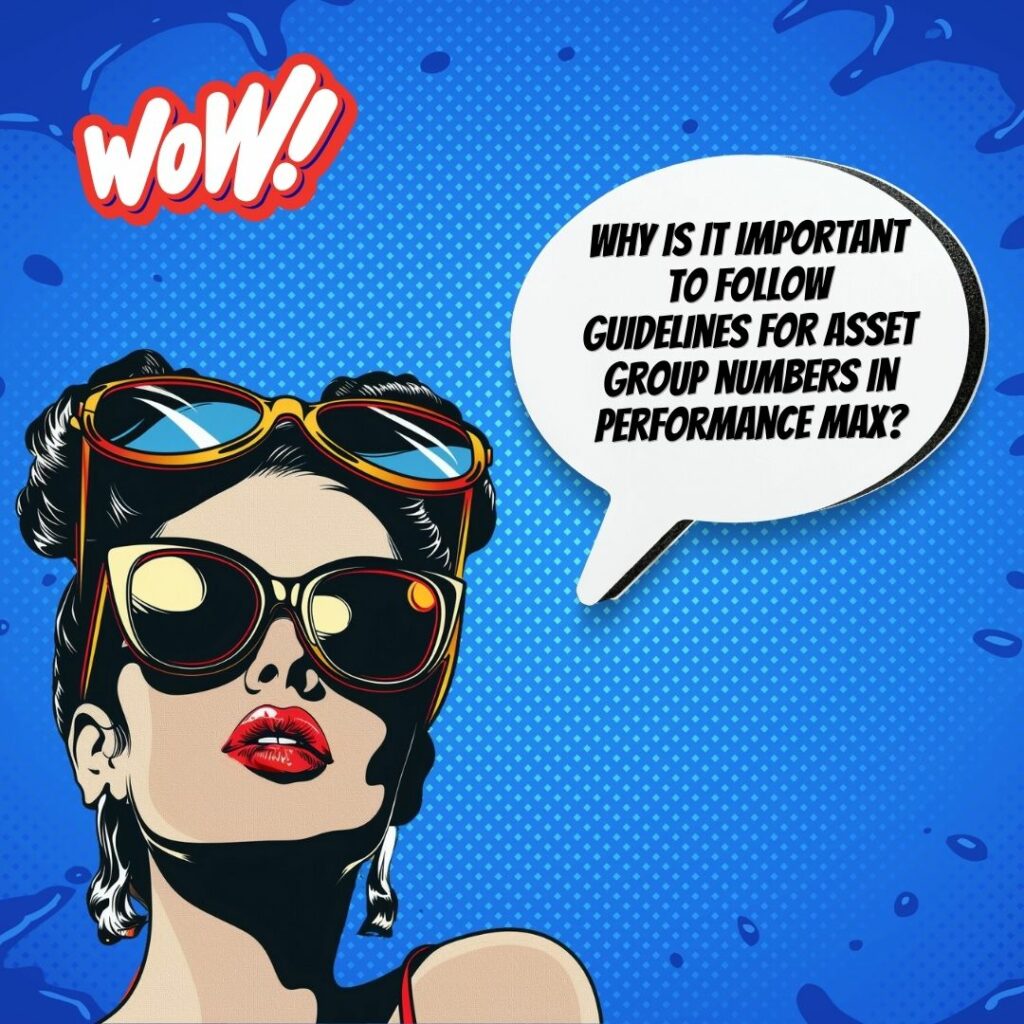Key Takeaways
✅ Asset group diversity and relevance are your tickets to truly resonating with your audience. Think about it: each group is a chance to talk directly to a customer's needs, interests, or dreams. Shouldn't that message be as spot on as possible? Businesses that tap into varied yet focused asset groups commonly see stronger engagement—because it's all about reaching the right people with the right message.
✅ The magic number of asset groups is a balancing act between granularity and scalability. Too many, and you're juggling more than you can handle; too few, and you might not be speaking loud enough in a crowded room. Businesses often kick off with 3-5 asset groups and tweak from there—bearing in mind their campaign goals and what the data tells them about customer behavior.
✅ Quality over quantity reigns supreme when considering consistent and high-quality assets within your groups. High-caliber, cohesive material speaks volumes to Google's algorithms and to your customers. Take the time to ensure each image, video, or snippet of text is a clear, engaging piece of your brand story—polished and ready to shine.

Introduction
Are you feeling stuck in the world of Google's Performance Max campaigns? Ever wonder just how many asset groups you ought to have working for you? If you've ever scratched your head over how to assemble that perfect mix for peak performance, trust me, you're not alone.
In this guide, we're cutting through the clutter to bring you the lowdown on creating an optimal setup with asset groups that could skyrocket your campaigns to new heights. From the smallest of tweaks that clear up confusion to the boldest of strategies pushing the envelope, we're laying it all out.
Want insider tips on tailoring your asset groups to sing in harmony with modern trends and maximize your revenue, ROAS, or ROI? Our insights could be the game-changer you're looking for. Stick around. We're about to deliver a platter of actionable insights and transformative information that could put you ahead of the game. Ready to make your Google campaigns hum with precision and efficiency? Let's turn those hopes into a plan of action.
Top Statistics
| Statistic | Insight |
|---|---|
| Ideal Number of Asset Groups: Google Ads Help suggests 6-10 for a Performance Max campaign. (Source: Google Ads Help) | Striking a balance with the right number of asset groups can target different audience segments more effectively. |
| Impact on Performance: Campaigns with over 10 asset groups see a 16% lower conversion rate. (Source: WordStream) | Too many groups might clutter your campaign, leading to a misfire rather than a bullseye. |
| Targeting Multiple Audiences: 72% of advertisers value targeting various audiences through Performance Max. (Source: Advertiser Perceptions) | Asset groups are your golden tickets for audience segmentation, introducing your ads to the right people. |
| Boost in Mobile Conversions: A 30% increase in mobile performance with Performance Max. (Source: Merkle) | Optimizing your asset groups for mobile isn't just advice, it's essential in today's constantly-connected world! |
| Future of Google Ads: An 18.6% growth in search ad revenue is anticipated for Google. (Source: eMarketer) | Staying ahead of the curve with Performance Max campaigns could mean climbing to the top of the industry ladder. |
Understanding Asset Groups
Have you ever wondered why asset groups are at the core of Google's Performance Max campaigns? An asset group in Performance Max is essentially a collection of your creative materials – think images, videos, headlines – all the things that tell the story of your brand or product. Each asset group you create is like a tailored suit for different segments of your audience. The secret sauce? Relevance. When your assets resonate with your customers, that's when you see the magic happen.
Determining the Ideal Number of Asset Groups
So, how do you hit that sweet spot – where you've got just the right number of asset groups? It's like a tailoring job; too few and you might not fit all your customers well, too many and you might lose focus. You have to weigh up your audience segmentation versus the scope of your campaign. It's all about finding that balance between granularity and the manageability. Can each asset group you create really strike a chord with a chunk of your audience?
Best Practices for Asset Group Creation
When you're stitching together your asset groups, there's a strategy to it. You'll want to weave in about 5 to 20 assets – a mix that represents your brand best. To keep things organized, think about clustering your assets around certain themes or objectives. Maybe you have a set for your eco-friendly line and another for your best-sellers. Are you making it easy for customers to tell your stories apart?
Monitoring and Optimizing Asset Groups
What happens after you set your asset groups live? It's not set and forget – it's like gardening, you've got to tend to it. Dive into your performance data to see what's thriving and what's not. Is there an asset group that's blooming like roses in spring? Give it some more room to grow. If something’s wilting, maybe it's time to prune. Refreshing your assets now and then keeps your garden – I mean, campaign – vibrant.
Advanced Strategies for Asset Group Management
Here's a thought – why not let your assets adapt like a chameleon? Dynamic assets can adjust to show what's most relevant to your customers. And when you sprinkle a little audience data into the mix, you can turbocharge your asset group performance. But remember, don't just settle on the first formula you try; keep testing and tweaking. It's like a recipe – sometimes it needs a bit more of this and a little less of that.
By focusing on creating asset groups that are well-structured and by continuously monitoring their performance, you're setting your Performance Max campaigns up for success. Remember, the best asset groups are those that are not only thoughtfully crafted but are also flexible enough to adapt to insights gained from ongoing performance data. Are you ready to see how fine-tuning your asset groups can help you reach your goals?
AI Marketing Engineers Recommendation
Recommendation 1: Start with a Focused Strategy: Begin with 2-3 Asset Groups focused on your distinct value propositions or primary services/products. Each group should represent a strong unique selling point to allow the Performance Max system to effectively differentiate and optimize. According to Google's best practices, having too few can limit learning, while too many may dilute performance. Recent data insights show that businesses with a well-defined and concentrated number of asset groups often see a more meaningful impact on their conversion rates.
Recommendation 2: Evaluate and Adapt to Performance Data: Use data-driven decision-making to evaluate the performance of each Asset Group. Track your conversion rates, click-through rates, and engagement metrics carefully. Keep an eye on the current trends showing that a proactive approach to refining asset groups based on performance indicators stands to gain efficiency in ad spend. Adjust your number of asset groups based on data over a significant period, typically after 4-6 weeks of performance review.
Recommendation 3: Leverage Machine Learning Insights: Implement a tool with machine learning capabilities, such as Google Analytics or Performance Max itself, to gather insights on asset performance. Smart technologies can predict which asset combinations are most effective, reducing the guesswork in your setup. The practical application of such tools has been proven to optimize ad reach and engagement, making your marketing budget work smarter, not harder. As trends sway towards AI-driven analytics, ensuring your setup is congruent with these tools is imperative for staying competitive.
Relevant Links
- Unlocking the Art of Affiliate Marketing: Passive Income Awaits!
- The Ultimate Decision: Chat GPT Free vs Paid Explained
- Marketing in 2024: Navigating the AI Revolution
- Turbocharge Your Campaigns: Secret Google Ads Strategies Revealed!
- Embracing AI in Marketing: The Future-Ready Analytics Guide
Conclusion
Well, you made it to the end of our little adventure through Google's Performance Max and the world of asset groups. Think about the journey we've been on together – from understanding what Performance Max can do for us, all the way to advanced strategies that could give our campaigns that extra zing. But let's get real for a second – knowing the number of asset groups to use can feel like a guessing game, right? However, it doesn't have got to be that way. Remember, each asset group is like a puzzle piece, fitting into your campaign strategy to show off different facets of what you've got to offer. And the magic number? It's not so much about sticking to a set figure but finding that sweet spot where relevance and reach meet.
Think about your audience – you know, the folks you really want to talk to. Splitting them up into meaningful chunks and pairing them with tailored asset groups is like setting up a coffee date; it's all about making the right impressions with the right people. Still, don't forget the best practices we chatted about. A handful of assets here, organized by themes or goals there, can dramatically lift your Performance Max campaigns off the ground. And as you go ahead, keep your eyes on the prize – use those monitoring tools and insights to keep tweaking and improving. Who knows where the next change might lead? Could be to the next big success story.
Now, take a deep breath. Armed with these guidelines, start experimenting with your asset groups. Let's make your Performance Max campaigns hum with efficiency and buzz with results. And hey, don't be shy; keep coming back to see how you can spice things up a little more. Who says you can't teach an old campaign new tricks? Keep pushing forward, keep optimizing, and most importantly, keep connecting with those special people out there waiting to discover what you have to offer. Ready to play around with those asset groups and see where they take you?
FAQs
Question 1: What is Performance Max in Google Ads?
Answer: Performance Max is a kind of campaign you can run with Google Ads. It's pretty clever – it uses something called machine learning to figure out the best way to show your ads across Google's different places, like when someone searches, on websites, on YouTube, in emails, and even when people are just looking at a map.
Question 2: How many asset groups should I have in Performance Max?
Answer: Google suggests starting with 3 to 5 asset groups for each Performance Max campaign. This gives their system a nice mix of your ads to play with. But really, the "right" number depends on a few things, like what you're trying to do, how much you want to spend, and what you're selling or offering.
Question 3: What are the benefits of having multiple asset groups in Performance Max?
Answer: Having a few different sets of ads means you can be more specific in who you target, show off more kinds of things you offer, and get your message in front of more people's eyes. This could mean better ad results and spending your money more wisely.
Question 4: Can I have too many asset groups in Performance Max?
Answer: There's technically no cap on how many you can have, but too many might make your head spin when you're trying to keep tabs on everything. The trick is to have enough variety but not so much that it gets overwhelming.
Question 5: What types of assets should I include in each asset group?
Answer: Think of each group like a little team that's got to have all the right players: text, images, videos, and catchy titles. They've all got to be top-notch, really grab people's attention, and make sense for whatever you're trying to sell.
Question 6: How do I optimize my asset groups for Performance Max?
Answer: Keep an eye on your ads, switch things up now and then, try different combos, and really pay attention to who is interested in what. Watch how things go and use that to make smart choices.
Question 7: Can I use the same assets across multiple asset groups?
Answer: Sure, you can, but mixing it up with different assets for each group could give you an edge since it keeps things fresh and relevant for your audience.
Question 8: How do I determine the best number of asset groups for my Performance Max campaign?
Answer: Start with the 3-5 groups everyone talks about and see how things go. If things are looking good and you've got more ads to show, you could add some more, but don't lose track of being able to manage them all smoothly.
Question 9: What are some advanced strategies for optimizing asset groups in Performance Max?
Answer: Some clever moves include letting the system create ads for you based on what you've uploaded (that's Dynamic Creative Optimization, or DCO), getting super targeted with who sees your ads, and letting real data guide your decisions on making and polishing your ads.
Question 10: What are some best practices for naming asset groups in Performance Max?
Answer: Choose names that make it crystal clear what's inside each group, stick to a naming style that works for you for all your campaigns, and keep it short and simple enough to avoid confusion.
Academic References
- WordStream. (2021). Google Ads Performance Max: How Many Asset Groups Should You Have Retrieved from www.wordstream.com/blog/ws/2021/01/26/google-ads-performance-max. This article from WordStream ventures into the balancing act of asset groups in Performance Max campaigns, proposing 5 to 10 as the sweet spot for efficacy that merges specificity with adaptability.
- Search Engine Land. (2021). Google Performance Max: What We've Learned So Far. Retrieved from searchengineland.com/google-performance-max-what-weve-learned-so-far-347899 .Search Engine Land brings to the table findings that suggest a plush portfolio of asset groups (10 or more) might be the key to thriving campaigns, albeit calling out the necessity for diverse assets to feed Google's algorithms.
- PPC Hero. (2021). Google Performance Max Campaigns: Everything You Need to Know. Retrieved from www.ppchero.com/google-performance-max-campaigns/. In this exploration by PPC Hero, the focus is on tailoring the number of asset groups to the complexity and diversity of one's business offerings, with a unanimous nod to the diversity of assets being vital for performance.












